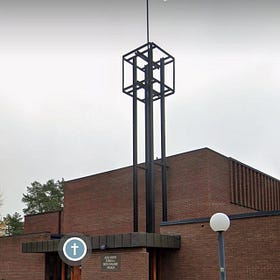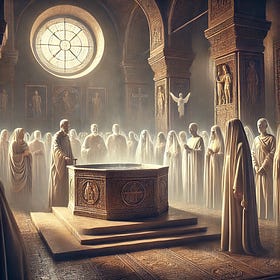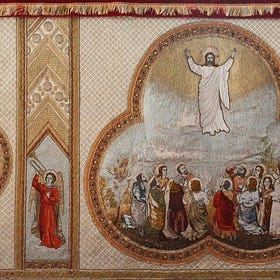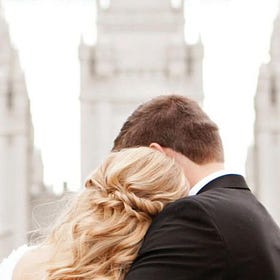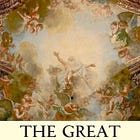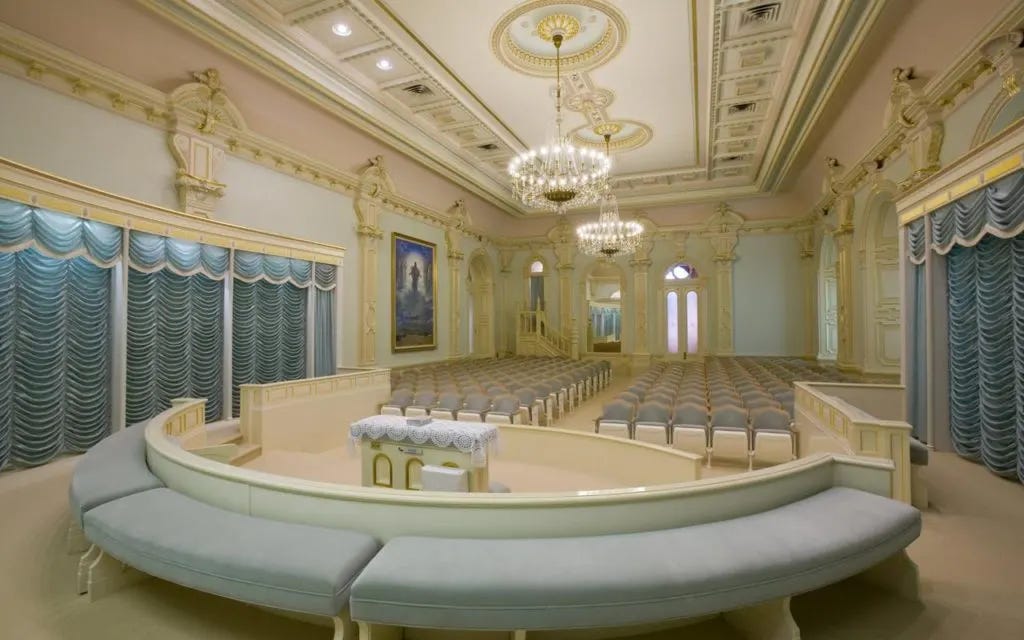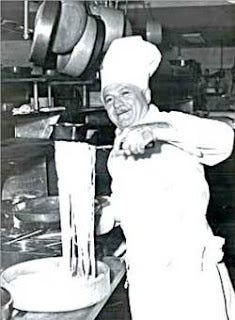Understanding the LDS Endowment Ceremony, Part 2 of 3
My attempt to Foster understanding - respectfully.
Last week we discussed part 1 of Understanding the LDS Endowment Ceremony. This article will continue where we left off and dive into the symbolism in the LDS Temple ceremonial clothing.
Understanding the LDS Endowment Ceremony, Part 1 of 3
Last week we discussed Baptism for the dead. This week we are going to look at the symbolism of the Endowment ceremony.
The Endowment as preparation for Exaltation
In my understanding, The LDS Endowment ceremony itself is not really about “Salvation,” as we think about it (although LDS leaders sometimes refer to temple rituals as “saving ordinances.” (But I think this is really saving for the dead, not necessarily the living.) For the living, it could be considered salvific in a few ways: 1) Increasing Sanctification, 2) the nature of the covenants you are making, and doing things to help us learn to keep those covenants. 3) Gaining knowledge necessary to make it to the highest level of heaven - LDS believe there are 3.) If you are not familiar with LDS Cosmology, please review the article below:
The Endowment is really about preparation for “Exaltation” or “deification/theosis.” You are endowed with the knowledge and make the Oaths necessary for you to become what you were previously anointed to in the Initiatory: a "King and High Priest in the Kingdom of Heaven." You could call it a type of King-making ceremony.
Endowment type ceremonies could be found anciently within many different religious groups and cultures. However, modern endowment ceremonies within Western traditions have largely disappeared as Monarchies have disappeared (but if you saw the enthronement of King Charles, you basically saw a King-making ceremony that had a religious framework attached to it.) An anthropologist would probably say that this is because ancient rulers were often seen as divinely appointed or actually divine. That "God and the King" or Queen are often mentioned together is not an accident, i.e., “God and the King” or “God and the Queen.”
Analogs still exist in Ancient Egyptian religions, in Christianity (Ordination of Clergy, Enthronements, etc.), Vodun (Fa Initiation), Orisha (Ifa Initiation or Coronation of a King or Oba), Santaria (Kariocha - the Making of a Saint or the Initiation of a Babalawo), Sikhism (Amrit Sanskar), Hinduism (Diksha), Tibetan Buddhism (Abhisheka), Shinto (Kanname-sai or Kannushi Ortination) and FreeMasonry, and other belief systems, religious and secular.
Although the patterns, frameworks, practices, clothing, symbols, oaths, covenants, and liturgies associated with these different practices may all differ, the major objective of the investiture of more significant roles and responsibilities, blessings, affirmations, oaths, covenants, and public acknowledgments are similar/common components. Many involve the addition of new or different vestments or garments as part of the process to visibly mark one as being set apart in a new and different role, emerging as a new "creation” with a new identity and even a new name.
The Egyptians had an endowment that was part of the king-making (pharaoh-making) ceremony; apparently, ancient Israelite and LDS endowment ceremonies take general cues or themes from this.[2]
Ancient religions in the Near East and Mediterranean had ‘endowment’ type ceremonies ranging from king-making to investiture and gnostic wisdom ceremonies.
The LDS temple ceremony was built on a masonic framework. Although it differs greatly in the details, process, liturgy, and symbolism used, it is undeniable that Joseph Smith (J.S.) used the framework and structure borrowed from the masonic ceremony in the construction of the Mormon endowment, including the masonic hand/arm signs and tokens.
There is nothing inherently wrong with this, I suppose (Unless you believe the FreeMasons to be demonic.) It’s not like there was/is only one way to do an endowment temple ceremony. Being that the law of Moses has been fulfilled, we should not expect to recreate Old Testament/Old Law/Old Covenant Temple worship, complete with animal sacrifices. Under the New Law/New Covenant of Christ, any temple ceremony should be different from the previous law, and with the Gospel promise of resurrection, deification, and everlasting life, it makes sense that any new Temple ceremony should be closer to an investiture or king-making ceremony; after all, an LDS Endowment is about exaltation.
Discussion of the Endowment is a sensitive topic. You can relax a bit; this is not an exposé.
Don’t worry. I'm not going to divulge the things we promise not to reveal in the Temple (i.e., the names, signs, and tokens.)
This is not an exposé.
What I'm going to cover, I believe, is fairly mundane, especially considering that you can find full video recordings of the entire endowment with a simple Google search. (Thank your friendly neighborhood Evangelical protestants or vitriolic ex-Mormons, who felt it necessary to desecrate the sanctity and privacy of your temple to get their tabloid “Mormon-Exposé" because they apparently "love you” and want to "save you.” It totally has nothing to do with getting social media influencer fame or hate or intolerance. Right? (Translation without the hypocritical marketing propaganda fake-Christian-double-speak - they secretly hate and loathe you, believe you are an evil cult akin to Scientology, and want to destroy your religion completely and totally and subject it to ridicule. How Christ-like of them, right? Well, their religion tells them they just have to say they believe; they don't actually have to do anything Christ-like to be "saved.”1) Salvation is fast, easy, convenient, and requires no effort or sacrifice; in fact, it costs nothing, The McDonald’s of American religion. In their defense, I believe that the majority of the time, this is being done by disaffected Mormons who are on their way out of the church and have become affiliated instead with some local protestant anti-mormon ‘counter-cult’ HATE group (let's call a spade a spade. Will the real heretics please stand up?2)
Instead, we discuss how to understand the structure and purpose and some of the symbolism in the LDS Endowment ceremony. This is necessary as few LDS people understand the endowment symbolism today. This article may be most helpful for those who have gone through the Endowment ceremony multiple times.
The Temple Journey
The ordinances of the temple follow the trajectory of our eternal progression: from Adam's fall to mortality on Earth and then back into God's presence. It's meant to orient, direct, and reinforce the trajectory of one's spiritual life and practice.
To facilitate this, Temples are built as models of the cosmos for the purpose of religious instruction (i.e., The Why and the Purpose of God's plan of Salvation for mankind). They are not meant to mirror physical scientific processes (The How and the What of creation, astrophysics, physical cosmology, i.e., The Big Bang, Inflation, and Evolutionary Sciences.)
Taken together, the Temple rituals can be seen as somewhat analogous to ancient King-Making ceremonies and religio-cultural rites of passage. The major rituals/ceremonies performed in an LDS temple are as follows:
Baptisms and confirmations - represent the initiation into the Gospel. A symbol of the death and resurrection of our old lives and rebirth into our new life as a disciple of Christ and membership in his Church. This is the first step in the entrance to the body of Christ (although an LDS person wouldn’t necessarily phrase it that way, they would say membership in "The Church" or "The Gospel.")
Your own personal Baptism and Confirmation usually do not happen in a Temple. It usually happens in your own Church (ward) building. As we covered a few weeks ago, baptism and confirmation in a Temple are usually reserved for performing these ordinances for the deceased. You can read that article here:
7- Vicarious works for the Dead, LDS BELIEFS THAT MATTER
·One of my subscribers asked me to write about Baptisms for the Dead, one of the more widely practiced and known LDS temple “sacraments,” also called “Vicarious works for the dead.”
Washing and Anointing (aka the Initiatory) - This is a purification ritual of preparation and initiation for participation in the Endowment service. You emerge from this phase purified and anointed, with a new name and Identity. We covered this portion in the previous article part 1. The purpose of the initiatory is to help you understand the purpose of the Endowment and some of its blessings to prepare you to participate in the Endowment.
Understanding the LDS Endowment Ceremony, Part 1 of 3
·Last week we discussed Baptism for the dead. This week we are going to look at the symbolism of the Endowment ceremony.
Endowment - Preparation/ for Exaltation, i.e. Deification through learning and instruction, as well as increasing your connection with God through the making and keeping of additional Covenants, followed by a "presentation to the Community” on you passing through the veil and ending up in the Celestial room.
You can read more about Exaltation here:
Theosis vs Exaltation
·This is really the third post in a series that examines some core fundamental beliefs, specifically around the nature of God, the nature and purpose of man, and soteriology. In this article, we will give a high-level overview of what both religions believe is the ultimate purpose, or end goal, of mankind, where they are similar and where they may differ.
Sealing - binding of a family unit together in the “highest order of the Holy Priesthood,” where the Husband and Wife can then be exalted together. You can read more about the significance of this here:
As mentioned above, the Temple endowment service proceeds in stages representative of our lives from the creation and fall of man all the to returning to the presence of God in the afterlife.
Many of these types of rituals progress through a pattern of phases such as:
Preparation / Initiation - (The Initiatory)
New Identity in the Community (Begins in the Initiatory which is capped by giving the participant a New Name.)
Seclusion and Ceremonial Instruction - where the participants learn things required for the next life and forge strong bonds with God by pledging to live in certain ways or uphold specific precepts required to fulfill their new role in the community.
Presentation to the Community - as a person with a new Identity. Other people welcome you with your new role and identity.
Temple Rooms - Progressing through the Ritual.
The Endowment ceremony represents a progression from Mortality to Deification; in some temples, this is played out by moving through different rooms representing different stages of progression from Human Mortality back to the presence of Divinity. It helps break up the monotony of the service while making this progression a lived experience.
In these older LDS temples (pre-1980s), the temple narrative was dramatized by temple workers (local volunteers tasked with working in the Temple - primarily retirees and young college students); this practice has been largely discontinued in favor of a film presentation. I was very fortunate to see it performed once with one of my adult children participating, but honestly, I found it as exciting as the film version unless my kid was “on stage" (and it took longer.) The Film versions have been around for decades.
The following pictures of Temple rooms are official images released by the LDS church (they show renderings of what the rooms in the Salt Lake Temple will look like after it is finished being renovated. - It is currently under renovation.)
The rooms are decorated with murals representing Creation, The Garden of Eden3, Earth, and Heaven.
The Creation room shows Earth in an unfinished form. This is where the recounting of the Creation as found in Genesis begins and represents the beginning of your journey and the phase of "seclusion and instruction." I call this "seclusion” because all of the participants are basically "locked away in time and space, separated from the rest of your LDS congregation for the duration of the ceremony and during this time, nobody else can spontaneously join it in progress or just randomly leave, unless you want to go to the bathroom, or decide that you cannot / refuse to, make the required covenants. The issue is that this invitation to leave is made before the participant has any idea of what the nature of these covenants will be, and after this point leaving seems not to be permitted.)
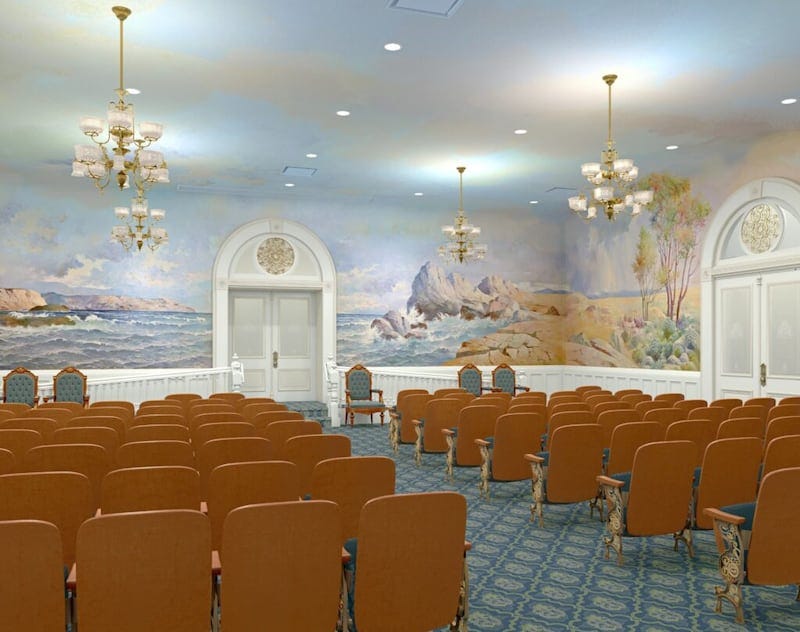
When the narration on the creation ends and the creation of Adam and Eve is to take place everyone moves to the next room, the "Garden of Eden room.” The presentation on creation continues here with the creation of Mankind. In this ritual, all the men represent Adam, and the women represent Eve.
The temple narrative adds to the Genesis account somewhat by dramatizing4 how God the Father put a plan into place to redeem mankind after the Fall, beginning with delivering his teachings to Adam and Eve via Angelic messengers while dealing with Lucifer who was immediately trying to lead them astray after the fall by mingling "scripture” with "the philosophies of men.” - reminiscent to me of a Charge against the Roman Catholic Church, by the Protestant Reformers.5
The Philosophies of Men - Mingled with Scripture
The "philosophies of men mingled with scripture” is a technique heavily emphasized by the Devil in the Temple ceremony numerous times. Lucifer talks about how he will lead the posterity of Adam and Eve astray using this method of deception.
The temple narrative and the way the information is presented also imply (at least to me) that the doctrines of all of the other churches of the world (particularly other Protestant denominations) have been corrupted by this deception and that the LDS church is the only true and living Church on the face of the earth.
The statement that "The Church of Jesus Christ of Latter-day Saints is the only true and living church on the face of the earth” is specifically made when participants make one of the temple covenants. This has the effect of creating a belief that the Devil has fully corrupted other religions and is a reinforcing message meant to keep people in the Faith through fear (my speculation and interpretation.)
This also creates/contributes to a common LDS cultural stigma that is applied to those who leave the LDS Faith. The connotation is that the Devil deceived you and led you astray into a belief system that he himself controls. This type of messaging is one of those things that leads to the accusation that Mormonism is a Cult.
I find the charge of "philosophies of men mingled with scripture” ironic, considering that this was used as an argument made by the Protestant reformers against the Roman Catholic church to advocate for non-biblical reformation philosophies such as Sola Scriptura and Sola Fide (Initially articulated by Martin Luther, and further developed by Zwingli and Calvin - which can accurately be described as "philosophies of men.”So -this charge was used to do exactly what it accused the Catholic Church of doing.) Moreover, Luther wanted to remove portions of the Bible (primarily the epistles of James) that conflicted with his philosophies (They did end up removing many books from the protestant bible - while running an effective marketing campaign to relabel the books they removed as apocryphal - and hence "not true” The LDS understanding of the Apocrypha is that they have some interesting and possibly faith promoting information, but that any truths in them were corrupted by human philosophical manipulation.)
It's also ironic to me because, during the Second Great Awakening, there were many popular religious "trends” and "theories”- you could say the "Philosophies” of Joseph Smith’s time such as “a Great Apostasy,” "Dispensationalism” and "restorationism” that Joseph Smith included in the fundamental theology and origin narrative of his new religion, which can be plainly seen in LDS Scripture: primarily the Book of Mormon and the Doctrine and Covenants.
(Warning to LDS readers: the following few paragraphs wander into some traditional anti-mormon objections - without expounding on the apologetic rebuttals in the narrative, though I do link to them.)
There were also other popular (and problematic) 19th-century protestant theories that, unfortunately, made it into Mormon religious doctrine (because the founders and early members all came out of this cultural milieu.) One is the assertion that the Native Americans were a remnant of ancient Israelites, i.e., some of the lost tribes of Israel. Finding proof of that would be the 21st-century equivalent of finding life on another planet. Joseph Smith made several statements about the Book of Mormon and the Native American tribes of the United States. Here are some examples:
"The Lamanites are the Indians... [The Book of Mormon] tells us that our forefathers were a people who came from Jerusalem... The principal part of the Lamanites are the Indians." (Joseph Smith, "History of the Church" vol. 4, p. 461)
"The Book of Mormon is a record of the forefathers of the American Indians, containing a history of their origin, a description of their journeyings, their wars, their persecutions, their wanderings, and their sufferings." (Joseph Smith, "The Pearl of Great Price," p. 107)
"The Book of Mormon asserts that the Native American is a descendant of Lehi and his two sons, Nephi and Jacob... We are informed that God commanded Lehi, a prophet of the Jews, to leave Jerusalem and go into the wilderness with his family... They journeyed many hundred miles until they came to the sea, which they crossed, and arrived in America." Source:** "Lecture on Faith" (circa 1835), p. 144. This is the same source as above.
In recent years, some critics have alleged that research demonstrating considerable homology between modern Native American, Mongolian, and southern Siberian DNA, as well as a seeming lack of homology between modern Jewish and Native American DNA, provides conclusive proof that the traditional LDS view of Native American origins is false. Some LDS defenders have attempted to explain the data by invoking limited geography theories proposing that Nephite and Lamanite activity was restricted to a small area in Central America and that any trace of “Israelite” DNA was lost by intermixing with larger indigenous groups. A closer examination demonstrates that DNA evidence does not discredit traditional LDS beliefs and that the claims of critics are based on non-factual assumptions and unsupportable misinterpretations of genetic data. Full Apologetic response
Please read my articles on the Apostasy for more detailed information - starting here:
This room represents the Garden of Eden.6 The presentation on creation continues here with the creation of Mankind. At this stage in the ritual, all the men represent Adam, and the women represent Eve. The temple narrative adds to the Genesis account somewhat by dramatizing how God the Father put a plan into place to redeem mankind after the Fall, beginning with delivering his teachings to Adam and Eve via Angelic messengers.
At a certain point in the progression of the service (when Adam and Eve are kicked out of the Garden of Eden), the participants are then ushered into a different room that represents the Earth (aka the Terrestrial Kingdom.) Here they receive the sacred knowledge required to return to God in Heaven, while also making promises to live their lives by certain precepts. Some of these may have changed over time (i.e., women no longer promise to obey their husbands), and there once was a time when the covenants included penalties or at least sworn acceptance of penalties should the covenants be broken.
These penalties appear to have been Masonic holdovers.7 The penalties were removed in the mid-20th century due to the discomfort they caused people. In my understanding, the penalties are the parts that modern Exorcists consider to be the dangerous/demonic parts as they could open you up to future retribution by a bad actor - granting them rights to have power over. (Small plug for one of my favorite podcasts - the Exorcist Files.) Since these penalties have long been removed, I think this is no longer a problem.
At a later point of instruction, when the participants have made the major covenants (promises to God to live by certain precepts) and received the required instruction, the participants may then be escorted into a third room (The "Terrestrial Kingdom") where there is a long temple "veil’ set up. The goal is to learn what you need to learn to pass through the Veil into yet another room called the Celestial Room. The formal end of the ceremony is when all participants use what they have learned to pass through the temple veil into the Celestial Room.
The Celestial Room is symbolic of Heaven with God our Father (If you go through with a group, this phase could be analogous to the Presentation to the Community phase.) It is separated from the Terrestrial Room by a veil (death) that all of us must pass through. If you are going through for your first time, your friends and loved one will be waiting to greet and congratulate you. As a TBM (true believing mormon) you have just taken a significant step in your LDS religious development!
Bursting the tabloid bubble….
As mentioned above, the Temple endowment service proceeds in stages representative of the journey of humanity from the creation and fall of man all the way to returning to the presence of God in the afterlife.
Contrary to popular opinion/belief, the LDS endowment ceremony is not set up in a room that in any way resembles a Masonic lodge. I know, sorry to disappoint you. Also, while I believe that the framework of this service may initially have been based on rites from Free-masonry (the first few degrees), I think that today, it likely bears little - if any, resemblance to the rites of Freemasonry, and nothing shocking or salacious happens there. Nothing gets sacrificed on an altar to Baphomet, there are no polygamous orgies There are no wiccan-like prayers to the devil or pentagrams on the floor. (FYI, modern mainstream Mormons (i.e. LDS members) do not practice polygamy - regardless of how many Sister Wives episodes you've seen, it's not a thing. 8
"Awwww!” …. Is that disappointment I hear? Sorry folks! Mormons and Mormon temple services are way, way more boring than social media and the internet have led you to believe. You don't need to see a video recording of this rite; these aren't the salacious, freaky-deaky polygamists you are looking for.
How frustrated would we be as Orthodox Christians if "protestant "Christians" and the media constantly misidentified us as Gnostics and misrepresented our beliefs as being Gnostic or Arian to the point where they create TV shows and YouTube channels dedicated to spreading these falsehoods and slandering our faith (Which does happen with ignorant 16th-century accusations like “You worship Mary and pray to Idols." We would be pretty angry and frustrated if that became what we were known for in mainstream society and people were blasting it over the airwaves at us 24/7. This kind of misrepresentation has been going on for Mormons relentlessly for over a century, and I can tell you - they are very, very tired of it.)
Reality Check
If you are really jonesing to experience this by watching some “expose online,” I would recommend against that for a few reasons. One it's really only personally/emotionally/spiritually meaningful if you are LDS and have been living an LDS life. Two, the LDS temple ceremonies are experiential. Watching it will just put you to sleep. It's something you need to experience (and even then it may still put you to sleep.)
I this is just something you *totally* have to do. Just imagine driving for hours to a movie theater that requires you to dress in a white suit, to watch a bad/boring B-movie about "the creation” presented in a rather creationist manner. Then you need to dress up in funny clothes; and once you start, you really can't leave (this is the seclusion and instruction portion.) Essentially locking you in for a couple hours of mind-numbing boredom. If you have ADHD or AuDHD like I do, it can be pure torture - esp. if you are going through it for someone else and not yourself.
There does come a point, however, where it can be kind of funny to look and see a room full of people who have been dressed up to look like how a 2-year-old might play dress up as Chef-boy-ardee. I always thought it looked like I was teleported to a Chef Boyardee look-alike convention.
Progressing through the Ritual
The rooms are decorated with murals representing Creation, The Garden of Eden, Earth, and Heaven. The Creation room shows Earth in an unfinished form. This is where the recounting of the Creation as found in Genesis begins and represents the beginning of your journey and the phase of "seclusion and instruction." I call this "seclusion” because all of the participants are basically "locked away in time and space, separated from the rest of your LDS congregation for the duration of the ceremony and during this time, nobody else can spontaneously join it in progress or just randomly leave, unless you want to go to the bathroom, or decide that you cannot / refuse to, make the required covenants. The issue is that this invitation to leave is made before the participant has any idea of what the nature of these covenants will be, and after this point leaving seems not to be permitted - although I don't think they'd really try to stop you at any point if you just got up and left - but I've never seen anyone try to do that.)

This room below represents the Garden of Eden. The presentation on creation continues here with the creation of Mankind. In this ritual, all the men represent Adam, and the women represent Eve. The temple narrative builds on the Genesis account somewhat by recalling how Adam and Eve fell and how God the Father put a plan in place to redeem mankind, beginning with delivering his teachings to Adam and Eve via Angelic messengers.
At a certain point in the progression of the service (when Adam and Eve are kicked out of the Garden of Eden), the participants are then ushered into a different room that represents the Earth (aka the Terrestrial Kingdom.) At a later point of instruction, when the participants have made the major covenants and received the required instruction, the participants may then be escorted into a third room (The "Terrestrial Kingdom") where there is a long temple "veil’ set up. The goal is to learn what you need to learn to pass through the Veil into yet another room called the Celestial Room. The Celestial Room is symbolic of Heaven with God our Father. It is separated from the Terrestrial Room by a veil (death) that all of us must pass through.
Modern Temples
Modern LDS temples (those build since the 1970's) do not have multiple rooms, with the exception of the Celestial Room (they all have one main Endownment room and a Celestial Room.) IN this case, which is now the vast majority, the ceremony happens all in one room with the presentation happening on Film. The film still has a number of “acts”if you will, which still take you through the same journey. (There's just less walking from room to room. I think this is unfortunate as the original layout does add to the experience, however, the LDS church is trying to be efficient with its use of space and capacity.)
The endowment film starts with the creation of the world. There are multiple versions of the film, with (by my recollection) some of the older ones being very creationist in approach and some of the newer ones being more scientific with how the creation of the solarsystem and the earth is portrayed with accretion disks, etc. As someone who is interested in cosmological physics and astronomy, I was happy to see this. They have not yet had any portrayal of the creation of life as evolutionary, however. I do hope that one day they'll drop the literalist approach to the creation of life, and embrace a more scientifically accurate and true approach by resolving the evolution question once and for all. But It is a ceremony that is primarily interested in teaching spiritual / religious truths, not scientific ones, so it's probably a moot point.
The service really get's into the main themes with the creation of Adam and Eve. At the end of the ceremony participants still end up at the "veil” of the temple, which they have to pass through to make it into the Celestial Room, passing through death and judgment into the glory of Heaven. Every Celestial room I’ve ever been in has been quite beautiful and peaceful. Celestial rooms are IMO, the pinnacle of LDS sacred architecture (interior to a building.) A Celestial room is probably the most sacred space in the LDS Faith.
The Temple Veil
Like Many things, the Veil in the temple is multi-vocal:
It's what separates us from the presence of God (in the Holy of Holies.) It's a demarcation point between the Fallen Sinful and Profane and the Sanctified, Holy, and Sublime.
As a symbol of the Eucharist. Hebrews 10:20
"By a new and living way, which he hath consecrated for us, through the veil, that is to say, his flesh;" Hebrews 10:20 in the King James Version (KJV)
I interpret "By a new and living way” in a manner that connects with the Covenants made in the Temple. These Covenants lay out a pattern for life to help you live as a Christian in a "New and living way." (Because Mormons believe that you have to live a Christ-like life, you cannot just proclaim belief. As an Orthodox Christian, I would agree and add that, AFAIK, that is the primary way one can become Sanctified and grow in God's Grace. As I understand it, Without "works of faith,” sanctification and attainment of Grace are difficult. Which I think is Addressed by the apostle James when he says, “Ye see then how that by works a man is justified, and not by faith only.” (James 2:24) and Paul says “For we are his workmanship, created in Christ Jesus unto good works, which God hath before ordained that we should walk in them.” (Ephesians 2:10)
What about the Covenants?
Perhaps the most important part of the Endowment is the making of sacred covenants. There are five covenants that participants make in the Endowment that I believe are fundamental to leading one to both Salvation and Exaltation. This also sets the expectations for LDS members regarding their LDS membership and how they are expected to live and behave.
Obedience - to obey God's commandments and live according to his will.
Sacrifice - Participants willingly covenant to sacrifice their time, talents, and resources for the building up of God’s kingdom on earth. This law represents a willingness to give up personal desires and comforts for the greater good and in the service of others.
A commitment to Living the principles of the Gospel of Jesus Christ, which include faith in Jesus Christ, repentance, baptism, receiving the Holy Ghost, and enduring to the end. It also encompasses the commitment to live a Christlike life, including the pursuit of charity, humility, and other virtues.
Chastity: Participants covenant to maintain sexual purity and moral integrity. This includes refraining from any sexual relations outside the bounds of a legally and lawfully recognized marriage between a man and a woman, as defined by the Church. Chastity also contains prohibitions against pornography and masturbation.
Law of Consecration: This is the most comprehensive covenant, wherein participants consecrate themselves, their time, talents, and everything with which the Lord has blessed them, or may bless them, to the building up of God’s kingdom on earth and the establishment of Zion. This covenant reflects a commitment to dedicate all aspects of one’s life to the service of God.
An Aside on Priesthood Roles
It is interesting - to me - to note that Female Temple workers are given limited "priesthood authority” to perform Initiatories, as it would be seen as indecent for men to be touching the bodies of naked women, and something that would invite abuse. This is the same rationale for the ancient practise of ordaining female Deacons in the early church.
Women who are temple workers are set apart by priesthood holders with the appropriate rights and authority to perform temple ordinances for other women. This is the only time/place in the LDS faith where women are granted priesthood authority to perform an ordinance or sacrament. Men do everything else - but that was not historically the case. In the days of Joseph Smith, women had more “priesthood” “rights.” i.e. they could give their children blessings in the name of their “husband’s priesthood.” That was considered a mother’s right and privilege. This changed later as the LDS Church became more codified and institutionalized, and the norms of American Society were imposed on them (as a result of the attempt to stamp out polygamy.) There was also an emphasis on the role of Fathers and the importance of Fathers living righteously and fulfilling their “priesthood” responsibilities in their families.
Temple Ceremonial Clothing / Vestments
Any Catholic or Orthodox Priest will be quick to say that they are a symbol of priesthood ordination or role but that the power is God's, not theirs.
Ironically, you hear this messaging, and then as a participant, not long after, you put on your own "vestments."
The Shield Garment Used During Initiatory
The shield during the initiatory is a symbol of the atonement. It is said to be are representation of what Christ used to cover the naked man - the night of His atonement in the Garden of Gethsemane (See Mark 14:51-52).
To be continued in part 3…….
Keep reading with a 7-day free trial
Subscribe to Latter-Day Saint to Orthodox to keep reading this post and get 7 days of free access to the full post archives.



